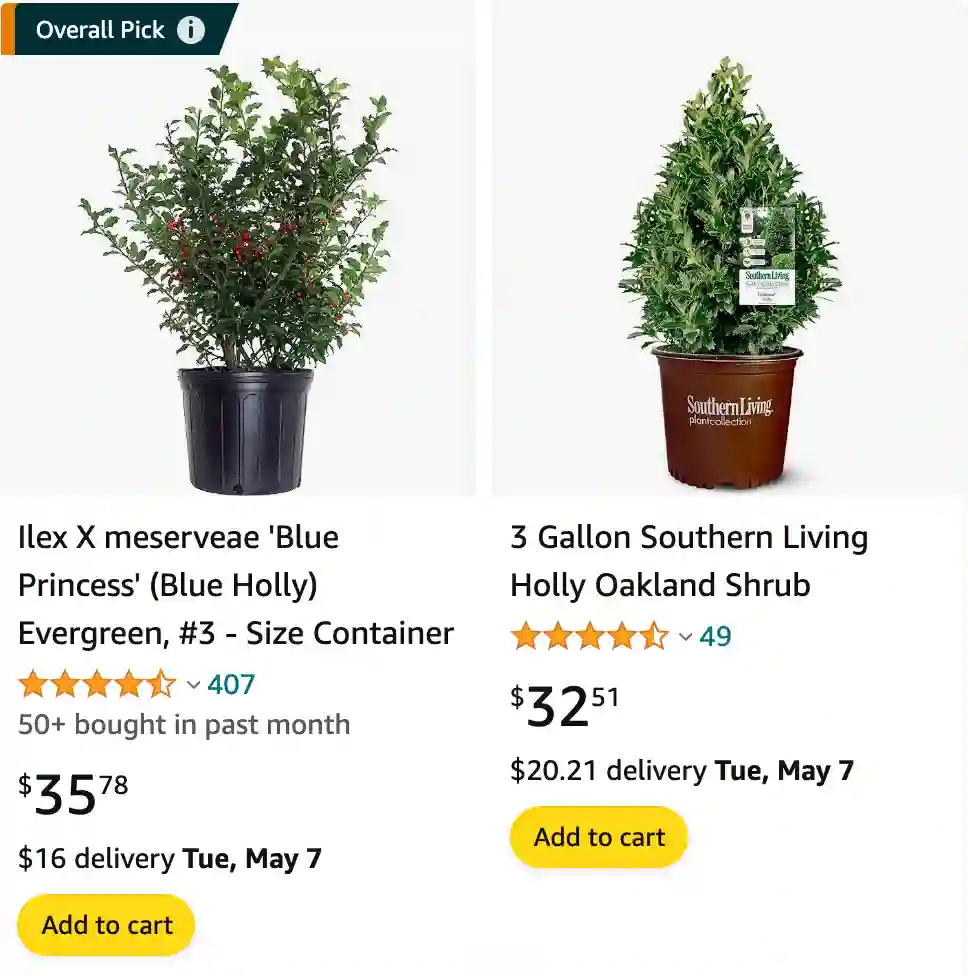





Top 100 Gift Ideas For Plant Lovers 2024
What is a holly tree?
As someone who spends a lot of time outdoors, I can tell you holly trees are those festive ones with shiny green leaves that always seem a little prickly. They’re the ones with bright red berries in the winter that birds love to gobble up. In the summer, they provide nice shade, and I remember building forts out of holly branches as a kid – though let me tell you, those spiky leaves will definitely teach you to be careful!
What does a holly tree look like?
Absolutely! Holly trees are like living Christmas decorations year-round. Their leaves are the most defining feature for me – a deep, glossy green that shines even on cloudy days. The edges are the trickiest part, though. They’re serrated, but not in a gentle way. More like prickly little spikes that can definitely catch you by surprise if you’re not paying attention. Then come the berries! In the fall, these bright red pops of color start appearing all over the tree. They’re like tiny Christmas ornaments, but way more tempting to a hungry bird (or a curious kid like I used to be – don’t recommend tasting them though!).

What is the holly wood tree used for?
The holly tree might be festive, but its wood isn’t as common a sight as the decorated branches. From what I’ve seen, holly wood itself isn’t super popular for furniture these days. Maybe it’s a bit too tough to work with. But I have come across some cool things made from holly wood! Once, at a craft fair, I saw a stall selling beautiful chess pieces – all carved from different woods. The dark red ones were holly, and they had a really smooth, polished finish that felt nice in your hands. There were also these gorgeous little decorative boxes with inlaid holly wood – the light wood next to the darker holly looked really sharp. So, while holly furniture might not be the norm, it can definitely add a touch of unique beauty to some special pieces.
Are berries from a holly tree poisonous?
Absolutely! Those festive red berries might look tempting, especially to curious kids or a hungry bird, but let me tell you, they’re best left uneaten. I remember a friend of mine (let’s call him Mike) dared me to try one as a kid. Big mistake! They’re not poisonous enough to be life-threatening (thankfully!), but they definitely pack a punch. Mike and I both ended up with upset stomachs for the rest of the afternoon – not exactly a fun experience. So, while the holly tree itself is beautiful, admire the berries from afar. They’re a pretty reminder to keep things hands-off and enjoy some holiday cheer from a safe distance!
When to cut holly tree?
The best time to cut a holly tree depends on what you’re using it for. Here’s how I approach it:
- For decorations: If you want some festive holly branches for the holidays, late fall or early winter is perfect. The berries are at their brightest red by then, and the weather’s usually cool enough that they’ll last a good while indoors. Just be sure to cut strategically so you don’t ruin the tree’s overall shape.
- For shaping the tree: If your holly is getting a bit out of control, late winter to early spring is a good window. The tree’s still dormant, so it won’t stress as much from the pruning. Plus, any new growth it puts out after the cut will have plenty of warm weather to mature before winter hits.
- Minor trims: Honestly, for small stuff like a broken branch or a pesky twig poking out where it shouldn’t, I don’t worry too much about the season. As long as it’s not freezing cold or the tree is actively flowering, a quick snip here or there won’t hurt it.
Can you cut off the top of a holly tree?
Cutting off the top of a holly tree, also known as topping, is something I would avoid if possible. Here’s why:
- Weird growth: Holly trees have a thing called apical dominance, which basically means the top leader keeps the whole thing growing in a nice, pyramid-ish shape. If you chop that leader off, the tree gets confused. It might sprout a bunch of new branches from the cut point, making it look bushy and uneven instead of neat and pyramidal. Not exactly the look most people are going for.
- Top-heavy trouble: Holly trees can get pretty tall. If you whack off the top, it can throw off the tree’s weight balance. Imagine a person standing on one leg – that’s kind of what you’re doing to the tree. It might become more susceptible to strong winds and even breaking.
There are better ways to control the height of a holly. You can selectively prune certain branches to encourage growth lower down, keeping the overall shape more natural. It might take a little more time and planning, but it will be better for the tree in the long run.
How fast do holly trees grow?
Holly trees are definitely not known for their lightning-fast growth. In my experience, they’re more on the slow and steady side. Most holly trees I’ve seen only grow about 6 to 12 inches a year. That means it might take a while for them to reach their full height, which can be anywhere from 15 to 50 feet depending on the variety. There is a faster-growing option, though. The Nellie Stevens holly is a superstar if you want a holly that puts on some serious size. Those can shoot up 2 to 3 feet a year, which is pretty impressive for a holly! But even the fast growers are marathon runners, not sprinters. So, if you’re planting a holly, be prepared to enjoy it for years to come as it matures into a beautiful part of your landscape.
How tall do holly trees grow?
As someone who’s spent a lot of time around these festive trees, holly height can be a bit of a surprise. They come in all shapes and sizes!
On one end, you’ve got the holly bushes. These guys are perfect for foundation plantings, staying compact at around 8 to 10 feet tall. Then there are your average holly trees, the ones you see lining streets or growing in parks. These can reach anywhere from 15 to 30 feet tall, giving you nice shade in the summer and a festive pop of color in the winter.
But holly trees can be real overachievers too. There are some varieties, like the American holly, that can shoot up to a whopping 50 feet tall! Those become majestic giants in a yard, perfect for providing privacy or a shady retreat on a hot day. Just remember, these height variations depend on the specific type of holly you have, so it’s always a good idea to check before planting one in your yard!
When to fertilize holly trees?
The best time to fertilize holly trees depends on giving them a little boost during their active growth phases. Here’s my experience:
- Spring feast: Just as spring peeks around the corner and the holly starts putting out new growth, that’s a perfect time for a feeding. It gives the tree a nice dose of nutrients to fuel all that fresh leaf production. I usually fertilize in late winter or very early spring, before any major growth spurts.
- Fall farewell: Another good time to fertilize is in the fall, after the summer heat has faded but before the first frost hits. This gives the holly a chance to build up its reserves for the winter ahead. Think of it like stocking up on pantry supplies before a long, cold season.
Some folks recommend a lighter feeding schedule, maybe three or four times a year, but I find the spring and fall approach works well for my holly trees. They always seem happy and healthy, with plenty of vibrant green leaves and those cheerful red berries come winter. Just remember, no matter when you fertilize, follow the instructions on the fertilizer package to avoid overdoing it.
Why has my holly tree lost all its leaves?
That sounds like a sad sight! There are a couple reasons why your holly might have shed all its leaves. Let’s see if we can figure it out:
- Winter Woes: Did we have a particularly harsh winter this year? Cold snaps and dry winds can definitely stress a holly tree, causing some leaf drop. Usually, the leaves will recover come spring, but if the damage was severe, it might take a while for the tree to fully bounce back.
- Water Worries: All plants need a good drink, and hollies are no exception. If your holly has been underwatered, especially during a hot, dry spell, it might shed its leaves as a way to conserve moisture. Check the soil around the base of the tree – is it dry and dusty, or moist and cool? If it’s dry, give your holly a good soaking and see if it perks up.
- Pesky Pests: Like all plants, hollies can be bugged by unwanted visitors. Some pests, like scale insects or leaf miners, can damage the leaves and cause them to fall off. Take a close look at the branches – do you see any crawling critters or unusual marks on the leaves? If so, you might need to treat the tree for insects.
- Fungal Funk: Fungal diseases can also be a culprit for holly leaf loss. One common one is holly leaf blight, which can cause leaves to develop black spots and eventually fall off. If you suspect a fungal infection, there are fungicide sprays available that can help.
The best course of action depends on the reason for the leaf loss. If you can narrow it down based on the clues above, I can help you find some solutions to get your holly healthy again!
What is the best fertilizer for holly trees?
In my experience, the best fertilizer for holly trees depends on a few factors, so there’s not a one-size-fits-all answer. Here’s what I consider when choosing fertilizer for my hollies:
- Acidity is key: Hollies are acid-loving plants, so you want a fertilizer formulated for that. Look for something with a balanced NPK ratio (nitrogen, phosphorus, potassium) and mentiones it’s suitable for acid-loving plants. Espoma Holly-Tone is a popular option, but there are others out there too.
- Slow and steady wins the race: Holly trees are moderate feeders, so a slow-release fertilizer is ideal. This will provide a steady stream of nutrients throughout the growing season without overwhelming the tree. Organic options like composted manure or composted leaves are great choices for slow-release fertilization.
- Spring and fall feeding: I find fertilizing in spring (late winter/early spring) and fall gives my hollies the boost they need. The spring feeding fuels new growth, and the fall feeding helps them build up reserves for winter.
Here’s a quick tip: Some folks like using coffee grounds around acid-loving plants like hollies. The grounds can add some acidity and nutrients to the soil, but be sure to use them in moderation – too much nitrogen from coffee grounds can be counterproductive.
Remember, always follow the instructions on the fertilizer packaging, regardless of which brand you choose. Overdoing it with fertilizer can be just as harmful as not feeding your holly tree at all. With the right fertilizer and a little care, your holly should be happy and healthy for years to come!
How do you kill a holly tree?
While holly trees can be beautiful additions to a landscape, sometimes removing them becomes necessary. Here are a couple ways to tackle a holly tree, depending on your preference and the size of the tree:
The Grinding Method:
- This method is best suited for smaller holly trees or large stumps left behind after cutting down a bigger one. You’ll need to rent a stump grinder, a powerful machine that essentially chews the wood and roots into chips.
- It’s a relatively quick and mess-free way to eliminate the holly, but grinding can be expensive depending on rental rates and may require some upper body strength to maneuver the machine.
The Cutting and Chemical Method:
- This method is effective for both larger and smaller holly trees. Here’s the process:
- Cut down the holly tree as close to the ground as possible using a chainsaw or axe.
- Once the tree is down, drill holes several inches deep and a few inches apart around the circumference of the stump.
- Apply a herbicide specifically formulated for brush control into the drilled holes and onto the freshly cut stump surface. Be sure to follow the safety instructions on the herbicide label closely!
- This method requires some muscle for cutting and the proper safety gear, but it’s a more affordable option than grinding. However, keep in mind that complete elimination may take several herbicide applications as the tree slowly dies and decomposes.
Natural Methods (Less Reliable):
There are also natural methods often attempted to kill holly trees, but they are generally less reliable and take much longer than the above methods. These include:
- Smothering the base of the tree with a tarp or thick layer of mulch to block sunlight for an extended period.
- Girdling the trunk by removing a complete ring of bark around the circumference, which disrupts the flow of nutrients.
The Takeaway:
Killing a holly tree requires some effort, but with the right approach it can be done. For smaller trees, grinding might be the quickest solution. For larger trees, a combination of cutting and applying herbicide is effective. Remember to prioritize safety when using any equipment or chemicals.



